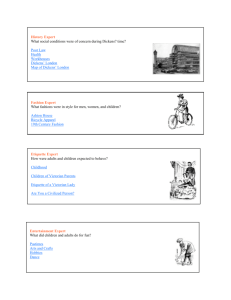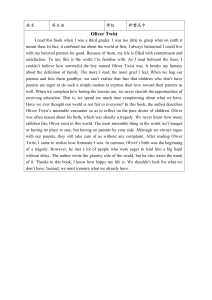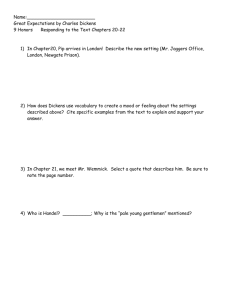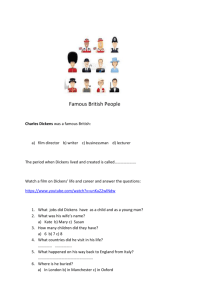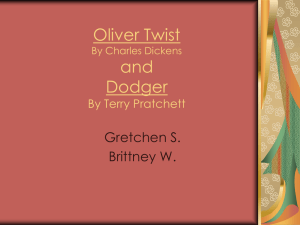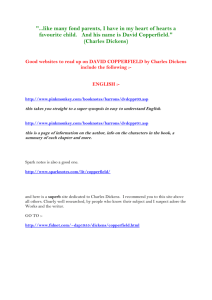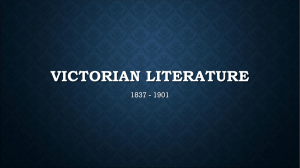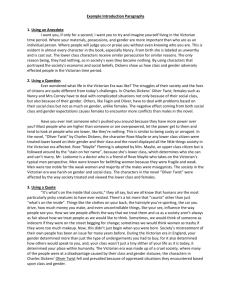THE WORLD VIEW OF CHARLES DICKENS IN OLIVER TWIST: A
advertisement
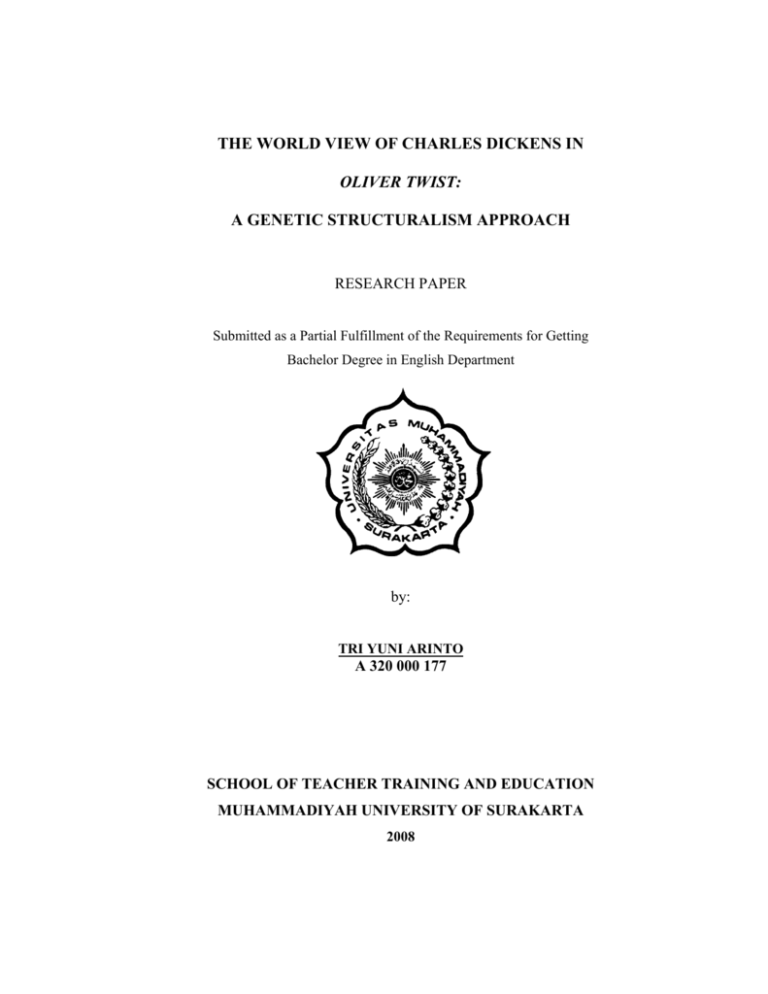
THE WORLD VIEW OF CHARLES DICKENS IN OLIVER TWIST: A GENETIC STRUCTURALISM APPROACH RESEARCH PAPER Submitted as a Partial Fulfillment of the Requirements for Getting Bachelor Degree in English Department by: TRI YUNI ARINTO A 320 000 177 SCHOOL OF TEACHER TRAINING AND EDUCATION MUHAMMADIYAH UNIVERSITY OF SURAKARTA 2008 1 CHAPTER I INTRODUCTION A. Background of the Study The Industrial Revolution which began in Europe in the late 18th century and early 19th century quickly spread to England. The late 19th century and early 20th century brought substantial industrial growth in England. Many British left terms and small towns to works in factories. By 1860, when British was population lived in urban areas and one third of the nation’s income came from manufacturing. English had grown into an industrial capitalist society by then. In an industrial capitalist society, the class division is between the factory owner and the worker. In industrial capitalist society the workers make goods in return for wages. They do not own the goods. The goods are sold to the market at a profit; hence, to get goods, workers have to buy them with money. This system makes the worker unable to play any roles the process of production Toward the 21st century there was a shift in structure of the English society. Manufacturing had declined significantly and the service sector had grown. The dominance of service jobs in the economy becomes irresistible. By the mid 1980s, three fourth of all employees worked in the service sector, for instance as teachers, physicians and other health care professionals, government employees, lawyers, and legal and financial specialist. This phenomenon is the characteristic of post-industrial society. For Bell (1973), a 1 2 post-industrial manufacturing to service industries centered on information technology. (Bell in Barker, 2000: 104). Industrial Revolution was an important event for human kind. It caused great changes not only in England but also the entire world. The effect of Industrial Revolution aroused in every single thing in human life, including education, philosophy, social, life even in religion aspect. The position of service class worker is not merely the same as the working class mentioned previously. The service class is not primarily involved in the direct production of good or commodities rather; they sell their skills and depend on their market power. They usually have high degree of autonomy, working either as professional experts or in directing other labors. Though they do not own the means of production, they may be shareholders or have the authority to manage the strategy direction of the company. On the contrary, the position of the working class in the postindustrial capitalist society become even harder, moreover, for those who cannot adapt to continuous economic, organizational, technological change. Firstly, they are alienated from the process of production. Secondly, they are intimidated by the dominance of the service class whether in the working sphere or in the social life since in a way of maintaining their identity through consumption, they have less income and consumption capabilities than the service class. The war always effects the circumstance or the certain environment, especially social, culture, politic, economic and more. That is why there are a lot of authors interested in reflecting the real situation into the literary work such as Charles Dickens (1812-1870) is considered to be one of 3 the greatest English novelists of the Victorian period. Dickens's works are characterized by attacks on social evils, injustice, and hypocrisy. Charles Dickens was born in Landport, Hampshire on February 7, 1812. His father was a clerk in the navy pay office, who was well paid but often ended up in financial troubles. In 1814 Dickens moved to London, and then to Chatham, where he received some education. He worked in a blacking factory, Hungerford Market, London, while his family was in Marshalea debtor's prison in 1824). In 1824-1827 Dickens studied at Wellington House Academy, London, and at Mr. Dawson's school in 1827. From 1827 to 1828 he was a law office clerk, and then worked as a shorthand reporter at Doctor's Commons. He wrote for True Son (1830-1832), Mirror of Parliament (18321834) and the Morning Chronicle (1834-1836). He was in the 1830s a contributor to the Monthly Magazine, and The Evening Chronicle and edited Bentley's Miscellany. In the 1840s Dickens founded Master Humphry's Clock and edited the London Daily News. Dickens's career as a writer of fiction started in 1833 when his short stories and essays appeared in periodicals. His Sketches By Boz and The Pickwick Papers were published in 1836.In the same year he married the daughter of his friend George Hogarth, Catherine Hogarth. The Pickwick Papers were stories about a group of rather odd individuals and their travels to Ipswich, Rochester, Bath and elsewhere. Dickens's novels first appeared in monthly installments, including Oliver Twist (1837-1839), which depicts the London underworld and hard years of 4 the foundling Oliver Twist, Nicholas Nickelby (1838-1839), a tale of young Nickleby's struggles to seek his fortune, and The Old Curiosity Shop (18401841). Among his later works are David Copperfield (1849-1850), where Dickens used his own personal experiences of work in a factory, Bleak House (1852-1853), A Tale Of Two Cities (1859), set in the years of the French Revolution and Great Expectations (1860-1861) From the 1840s Dickens spent much time traveling and campaigning against many of the social evils of his time. In addition he gave talks and reading, wrote pamphlets, plays, and letters. In the 1850s Dickens was founding editor of Household Words and its successor All the Year Round (1859-1870). In 1844-45 he lived in Italy, Switzerland and Paris. He gave lecturing tours in Britain and the United States in 1858-68. From 1860 Dickens lived at Gadshill Place, near Rochester, Kent. He died at Gadshill on June 9, 1870. The unfinished mystery novel The Mystery Of Edwin Drood was published in 1870. Throughout all of Charles Dickens’ writing, the writer is interested by the worldview of Charles Dickens. The writer will analyze it in Charles Dickens’ Oliver Twist: through genetic structuralism approach. Dickens' second novel tells the story of the orphan Oliver set against the seamy underside of the London criminal world. Published in monthly parts in Bentley's Miscellany, partly concurrent with Pickwick and Nicholas Nickleby, the novel was illustrated by George Cruikshank. 5 In this departure from the merry world of Pickwick, Dickens targets the Poor Law Amendment Act of 1834 which renewed the importance of the workhouse as a means of relief for the poor. Dickens was severely criticized for introducing criminals and prostitutes in Oliver Twist, to which Dickens replied, in the preface to the Library Edition of Oliver Twist in 1858, "I saw no reason, when I wrote this book, why the very dregs of life, so long as their speech did not offend the ear, should not serve the purpose of a moral, at least as well as its froth and cream". The novel was well received but not with the adulation of Pickwick. One of the most dramatized of Dickens' works, Oliver Twist was appearing in 10 theaters in London before serialization of the novel was even completed. The Internet Movie Database lists nearly 25 film versions, the first in 1906. Academy Award winning filmmaker Roman Polanski is the latest to bring the little orphan boy to the silver screen. Polanski's Oliver Twist opens in theaters September 30, 2005. B. Literary Review In analyzing this novel, the writer finds other researchers that discuss the different novel, but same in analyzing approach. Firstly, (Tri Wahyuni: 2001), in this research entitled “Racial Interaction In James Fenimore Cooper’s The Last Of The Mohicans: Genetic Structuralism Approach”, the writer emphasizes the analysis on relating the structure of the work to the large structure of the social realities in which the work was made. Secondly, 6 (Dremo Prasojo: 1999). Social Maturation in MARK TWAIN‘S The Adventures Of TOM SAWYER: A Genetic Structuralism Approach. To fulfill the aim of this research and to limit this analysis, the researcher will focus on analyzing Charles Dickens’ works, in this case is Oliver Twist. It will focus on social phenomenon which is reflected in Oliver Twist and Charles Dickens’ worldview of the Industrial Revolution in his literary works, Oliver Twist. C. Problem of the Study The problem of the study: "What is Charles Dickens’ worldview on the influence of English industrial revolution in his novel Oliver Twist? D. Limitation of the Study To carry out the study, the researcher needs to limit the study in order to make it easier in analyzing the novel through the author’s view only. The researcher is going to analyze the author’s view through genetic structuralism approach. E. Objectives of the Study In this research paper, the writer has objectives to analyze the influence of English industrial revolution in his novel Oliver Twist: 1. To analyze the structure of Oliver Twist and 2. To identify the relation between the structure of Oliver Twist and the social historical background 7 F. Benefits of the Study The writer takes a great expectation that the study will have the benefits as follows: 1. Theoretical Benefits: a. The study is expected to contribute the literary study on Charles Dickens’ Oliver Twist. b. The study is expected to find out the researcher’s curiosity about life and the influence of English industrial revolution in 18th century in English. 2. Practical Benefit: The study enriches the literary study, particularly among the students of Muhammadiyah University of Surakarta. G. Research Method In analyzing the sociology of Oliver Twist and revealing Charles Dickens’ worldview, the writer uses the qualitative method. 1. Research Object The research object in this study is the main character and socioculture conflicts in Charles Dickens’ Oliver Twist. 2. Type of the Data and the Data Sources This study uses library data, which are classified into two categories; primary and secondary data. The primary data are the texts of “Oliver Twist”, whereas, the secondary data include material about 8 genetic structuralism, the theory literary criticism and other materials relevant to the analysis. 3. Technique of the Data Collection In this research, the writer uses the library in collecting data, the present writer follows some steps such as: a. Reading Oliver Twist novel. b. Reading some related books to get the theory, data information. c. Understanding parts of the related books also of the work. d. Writing the data on certain papers. e. Classifying the data into groups according to categories elements of literary study. 4. Technique of the Data Analysis The technique of analysis the data in this study is descriptive and hermeneutic by interpreting the text in order to find out the most probable intention of the author. H. Paper Organization This research paper consists of six chapters. It begins with Chapter 1 that comprises of the introduction, which includes background of the study, literary review, problem statements, objective of the study, limitation of the study, benefit of the study, theoretical approach, research method, and paper organization. In Chapter II, the writer presents the underlying theory of Genetic Structuralism. The biography of the author and Historical 9 Background of The South Society is presented in Chapter III while in Chapter IV consists of structural analysis of the novel Oliver Twist. Chapter V composes sociological analysis. Finally, the writer concludes the paper in chapter VI.

